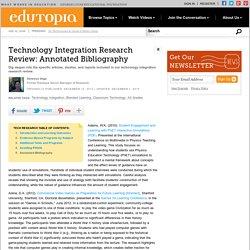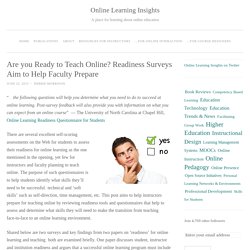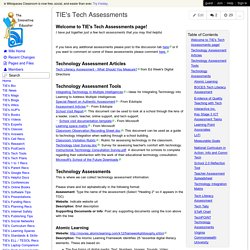

Conference Presentations. Presentations March 2016: Virginia Association of School Librarians, Shenandoah (Weyers Cave); James (Petersburg); and Rappahannock (Warsaw) Regional Conferences: On the Edge with the Top Ten Topics and Trends November 2015: Virginia Association of School Librarians, Williamsburg, VA: On the Edge with the Top Ten Topics and Trends of 2015 (Handout); AASL Best of...

(Co-presenter) November 2015: New Jersey Association of School Librarians, Long Branch, NJ: AASL Best of... November 2015: American Association of School Librarians, Columbus, OH: Education Evolution with NxtWave: Leaders for 21st Century School Libraries (Co-presenter) Technology Integration Research Review: Annotated Bibliography. Adams, W.K. (2010).

Student Engagement and Learning with PhET Interactive Simulations (PDF). Presented at the International Conference on Multimedia in Physics Teaching and Learning. This study focuses on understanding how students use Physics Education Technology (PhET) simulations to construct a mental framework about concepts and the effect levels of guidance have on students' use of simulations. Hundreds of individual student interviews were conducted during which the students described what they were thinking as they interacted with simulations. Careful analysis reveals that showing the invisible and use of analogy both facilitate students' construction of their understanding, while the nature of guidance influences the amount of student engagement. Arena, D.A. (2012). Arici, A. (2008). Bakia, M., Shear, L., Toyama, Y., and Lassseter, A. (2012).
Barab, S.A., Scott, B., Siyahhan, S., Goldstone, R., Ingram-Goble, A., Zuiker, S., and Warren, S. (2009). Caldwell, J.E. (2007). U.S. Improving Educational Technology Integration in the Classroom. Are you Ready to Teach Online? Readiness Surveys Aim to Help Faculty Prepare. “…the following questions will help you determine what you need to do to succeed at online learning.

Post-survey feedback will also provide you with information on what you can expect from an online course” — The University of North Carolina at Chapel Hill, Online Learning Readiness Questionnaire for Students There are several excellent self-scoring assessments on the Web for students to assess their readiness for online learning as the one mentioned in the opening, yet few for instructors and faculty planning to teach online. The purpose of such questionnaires is to help students identify what skills they’ll need to be successful; technical and ‘soft skills’ such as self-direction, time management, etc. This post aims to help instructors prepare for teaching online by reviewing readiness tools and questionnaires that help to assess and determine what skills they will need to make the transition from teaching face-to-face to an online learning environment. 1. 2. 3. 1. 2. Resources. The Learning House New Tool Assesses Instructor Readiness, Then Offers Training - The Learning House.
Subscription Only March 15, 2013 With the rapid increase in students taking online courses, it grows daily more crucial for administrators to find faculty who understand teaching and learning in that environment.

Beyond just achieving the learning outcomes for the course, good online instruction plays a clearly recognized role in student retention and persistence. Assessing Instructor Readiness to Teach Online Courses. In 2009, approximately 5.6 million students enrolled in at least one online course, representing 30% of all higher education students 1.

With the increase of students taking online courses, administrators must find faculty who understand how to pedagogically achieve program outcomes. In addition, quality online instruction should play a role for student retention and persistence. What is missing is the assessment tool an online administrator may use to evaluate instructors' readiness to transition from face-to-face to an online environment. The Southern Regional Education Board (SREB) reports that face-to-face instructor skills do not necessarily transfer to an online classroom.
In a traditional class, the instructor combines instructional and content knowledge to determine which instructional strategies, activities, and assessments to use. TheInnovativeEducator - TIE's Tech Assessments. I have put together just a few tech assessments that you may find helpful.

If you have any additional assessments please post to the discussion tab here or if you want to comment on some of these assessments please comment here.Tech Literacy Assessment - What Should You Measure? From Ed Week's Digital DirectionsIntegrating Technology in Multiple Intelligences - Ideas for Integrating Technology into Learning to Address Multiple IntelligencesSpecial Report on Authentic Assessment - From EdutopiaAssessment Articles - From EdutopiaSchool Visit Report: This document can be used to look at a school through the lens of a leader, coach, teacher, online support, and tech support.
Atomic Learning Website: The Atomic Learning Framework identifies 25 “essential digital literacy elements. BOCES Tech Literacy Assessment Evidence of Quality Teaching with Tech Website:Description: Online technology teaching assessment to help schools plan their professional development. Interactive Inc. LoTi Tech Tally. Integrating-Technology-with-Student-Centered-Learning. Editorial. Harris, J. (2005).

Our agenda for technology integration: It's time to choose. Contemporary Issues in Technology and Teacher Education [Online serial], 5(2). Measuring Teachers' Readiness. Friday Institute Evaluation Team.